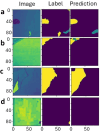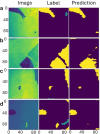Machine learning enabled fast optical identification and characterization of 2D materials
- PMID: 39537855
- PMCID: PMC11560962
- DOI: 10.1038/s41598-024-79386-z
Machine learning enabled fast optical identification and characterization of 2D materials
Abstract
Two-dimensional materials are a class of atomically thin materials with assorted electronic and quantum properties. Accurate identification of layer thickness, especially for a single monolayer, is crucial for their characterization. This characterization process, however, is often time-consuming, requiring highly skilled researchers and expensive equipment like atomic force microscopy. This project aims to streamline the identification process by using machine learning to analyze optical images and quickly determine layer thickness. In this paper, we evaluate the performance of three machine learning models - SegNet, 1D U-Net, and 2D U-Net- in accurately identifying monolayers in microscopic images. Additionally, we explore labeling and image processing techniques to determine the most effective and accessible method for identifying layer thickness in this class of materials.
© 2024. The Author(s).
Conflict of interest statement
Figures






References
-
-
Han, T. et al. Investigation of the two-gap superconductivity in a few-layer NbSe
 -graphene heterojunction. Physical Review B97(6), 060505 (2018).
-graphene heterojunction. Physical Review B97(6), 060505 (2018).
-
Han, T. et al. Investigation of the two-gap superconductivity in a few-layer NbSe
-
- X. Chen, et al. “Probing the electronic states and impurity effects in black phosphorus vertical heterostructures,” 2D Materials, vol. 3, no. 1, p. 015012, 2016.
-
- Wu, Y. et al. Negative compressibility in graphene-terminated black phosphorus heterostructures. Physical Review B93(3), 035455 (2016).
-
- Wang, K. L., Wu, Y., Eckberg, C., Yin, G. & Pan, Q. Topological quantum materials. MRS Bulletin45(5), 373–379 (2020).
-
- B. Zhang, P. Lu, R. Tabrizian, P. X.-L. Feng, and Y. Wu, “2D magnetic heterostructures: spintronics and quantum future,” npj Spintronics, vol. 2, no. 1, p. 6, 2024.
LinkOut - more resources
Full Text Sources

